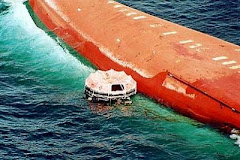
If a ship floods, the loss of stability is due to the free surface effect, as the water accumulating in the hull will be in the bilges, lowering the centre of gravity and actually increasing the metacentric height. This additional mass will however reduce freeboard (distance from water to the deck) and the ship's angle of down flooding (minimum angle of heel at which water will be able to flow into the hull). The range of positive stability will be reduced to the angle of down flooding resulting in a reduced righting lever. When the vessel is inclined, the fluid in the bilge will move to the lower side, shifting its center of gravity toward the list, further extending the heeling force. This is known as the free surface effect
Flooding, liquid cargo leakage, or unintended water (from precipitation or waves) in any compartments or on any decks of watercraft, and the resulting free surface effect are often a contributing cause of accidents, capsizes and casualties e.g. the loss of TEV Wahine (Wellington, New Zealand, April 1968), the MS Herald of Free Enterprise (Zeebrugge, Belgium, March 1987), and MS Estonia (Baltic Sea, September 1994).
The free surface effect is one of several mechanisms where a craft can become unstable and roll-over (capsize). It refers to the tendency of liquids — and of aggregates of small solid objects, like seeds, gravel, or crushed ore which can act as liquids — to move in response to changes in the attitude of a craft's cargo holds, decks, or liquid tanks in reaction to operator-induced motions (or sea states caused by waves & wind acting upon the craft).
The free surface effect can become a problem in a craft with large partially-full bulk cargo compartments, fuel or water tanks, especially if they are located spanning its fore to aft centerline. If a compartment or tank is either empty or full, there is no change in the loading of the mass, or the craft's center of mass as it rolls from side to side (in strong winds, heavy seas, or on sharp motions or turns). If the tank is only half-full, however, the liquid in the tank will respond to the craft's heave, pitch, roll, surge, sway or yaw. For example, as the craft rolls to the left (port), a liquid will move so that much of it is now on the left (port) side of a tank, and this will move the craft's center of mass and center of moment towards the left (port). This has the effect of slowing the craft's return to vertical.
The free surface effect becomes worse if the craft then rolls through the vertical towards the right (starboard). It takes time for the liquid in the tank to respond and move towards the right (starboard) side of the tank. After the craft rolls through the vertical towards right (starboard), most of the liquid moving in the craft's tank then slams into the right (starboard) side of the tank, often with the effect of causing the craft to heel further over, as the liquid mass hits the bulkheads of the tank. In turbulent winds, heavy sea states, or on rough roads, this can become a positive feedback loop, causing each roll to become more and more extreme, until the craft rolls-over (capsizes).
The higher up these fluid motions occur, especially above either the craft's center of moment (buoyancy) or center of mass, the more pronounced the instabilities.
To mitigate this hazard, cargo vessels use multiple smaller bulk compartments or liquid tanks, instead of fewer larger ones, and possibly baffling within bulk compartments or liquid tanks to minimize the free surface effects on the craft as a whole. Keeping individual bulk compartments or liquid tanks either relatively empty or full is another way to minimize the effect and its attendant problems.
Free surface effect can affect any kind of craft: ranging from watercraft (where it is most common) to bulk cargo or liquid tanker semi-trailers and trucks (causing either jackknifing or roll-overs), or aircraft (especially fire-fighting water-drop and refueling tankers where baffles mitigate but do not eliminate the effects).






No comments:
Post a Comment